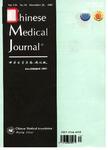Alendronate treatment does not inhibit bone formation within biphasic calcium phosphate ceramics in posterolateral spinal fusion: an experimental study in porcine model
Alendronate treatment does not inhibit bone formation within biphasic calcium phosphate ceramics in posterolateral spinal fusion: an experimental study in porcine model作者机构:Orthopedics Research Laboratory Spree Section E Institute Ior Experimental Clinical Research Aarhus University Hospital Aarhus Denmark Department of Orthopedic Beijing Hospital Beijing 100730 China ng Hospital Beijing 100730China
出 版 物:《Chinese Medical Journal》 (中华医学杂志(英文版))
年 卷 期:2009年第122卷第22期
页 面:2770-2774页
核心收录:
学科分类:0710[理学-生物学] 071010[理学-生物化学与分子生物学] 080503[工学-材料加工工程] 081704[工学-应用化学] 07[理学] 08[工学] 0817[工学-化学工程与技术] 0805[工学-材料科学与工程(可授工学、理学学位)]
基 金:Association of Rheumatology [233-845-07.06.01]
主 题:spinal fusion alendronate calcium phosphate computed tomography
摘 要:Background Biphasic calcium phosphate (BCP) ceramics has a potential advantage as an osteoconductive matrix and has an optimal resorption rate for bone formation. Using BCP ceramics as a bone graft during spinal fusion requires osteogenesis within the material and subsequent bridging between adjacent vertebraes to provide long-term support. Bisphosphonates have been reported to prolong the process of bone healing. The influence of bisphosphonate treatment on bone formation within BCP ceramics in spinal fusion remains unknown. The aim of this study was to evaluate the influence of alendronate on BCP osteoaenesis in Dosterolateral spinal fusion. Methods Posterolateral spinal fusion with pedicle screw fixation was performed at the lumbar spine in twenty-two pigs. BCP ceramics were applied as a bone graft to obtain bone fusion between adjacent transverse processes. Eleven pigs in the treatment group received oral alendronate 10 mg/d for three months postoperatively. Eleven pigs in the control group did not receive treatment with alendronate. All animals underwent posterolateral spinal fusion with BCP ceramics. The fusion rate was evaluated three months after the operation. Results The fusion rates evaluated by X-ray were 27.3% in the treatment group and 20% in the control group. The fusion rates using histological evaluation were 18.2% in the treatment group and 20% in the control group. The mean volumes of fusion mass were (3.64±0.86) cm^3 in the treatment group and (4.26±0.63) cm^3 in the control group. No significant differences were found in either trabecular bone volume or residual BCP volume between treatment and control groups using histological evaluation. The new bone formation within BCP ceramics was greater in the area adjacent to transverse process (P 〈0.01). Conclusion Oral alendronate with a dose of 10 mg daily do not inhibit bone formation within BCP ceramics or affect the fusion rate in posterolateral spinal fusion from porcine models.



